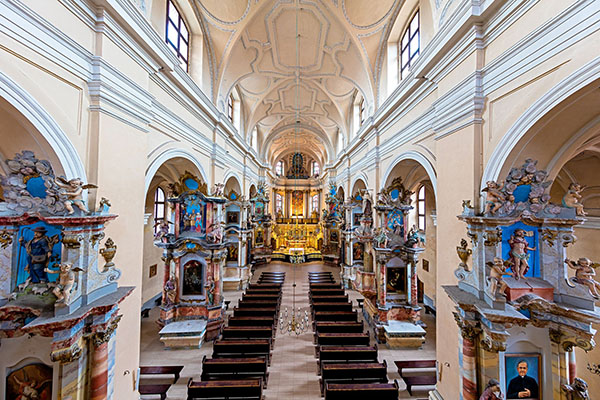
This Church is included as part of Places of Marian Devotion.
The Church of All Saints was built in Vilnius in 1632 by Vaitiekus Adalbertas Chludzinskis, the secretary to Sigismund III Vasa, the King of Lithuania and Poland. At the time, it was located on the outskirts of Vilnius – near the southwestern city walls and the former location of the Rudininkai Gate. In 1628 the construction of the monastery was completed after the previously existing buildings were joined together. The monastery became one of the main centers for the Carmelites of the Ancient Observance in the Grand Duchy of Lithuania. When it was established in 1810, All Saints Church was one of the largest parishes in Vilnius, expanding to more than 12,500 parishioners by 1830.
In 1743, a Late Baroque-style bell tower was added to the left side of the facade of the Church. This tower reflects the Baroque traditions of Vilnius and has become one of the most noticeable buildings of the Old Town. At the end of the 18th century, the Church was renovated as well. It was designed as a three-nave basilica, with a deep presbytery and two side chapels with cupolas. All Saints Church has 18 altars, which are decorated with paintings, brightly colored sculptures, and gold-colored decorative elements.
After the uprisings of 1831 and 1863, monks from other closed monasteries were re-settled at the Carmelite monastery; and a prison for priests was established there as well. In 1886 this was the last Roman Catholic monastery to be closed in Vilnius. The Society of Children’s Orphanages took over the building in 1887, and later the building was remodeled to house apartments and stores. During the Soviet years, the monastery buildings continued to be used as apartments, with stores occupying the first floor, and the Department of Folk Art of the LSSR Art Museum was located there as well. At the same time, the Church was used as a warehouse and as the Vilnius Art Museum exhibition hall between 1975 and 1990.
Hanging above the altars until the Church was closed were eleven paintings with metal coverings attesting to the graces granted to the faithful through these images. In 1991 the Church was returned to the faithful, the Shrine was updated, and some of its paintings were returned. Above the altar, located on the left side of the Church, hangs a painting of Madonna with Child decorated with metal coverings, which previously belonged to the Carmelites; on the other side above the right altar, hangs a treasured 17th century Carmelite iconographic painting of Our Lady the Savior of Souls in Purgatory.
Mother of God – the Savior of Souls in Purgatory and the Carmelite devotion to Mary. The Carmelites considered the Blessed Virgin Mary a perfect example of a prayerful life, showing us the way to God. In Lithuania, the Carmelites popularized the practice of praying for the dead, which was associated with the devotion to Our Lady. At that time purgatory, as a place where souls went to be cleansed of vices and shortcomings before reaching eternal life, occupied an important place in religious beliefs. The Mother of God is considered the most important intercessor and attendant of souls in need of reconciliation with God.
Monday – 3 p.m.–7.30 p.m.
Tuesday–Friday – 11 a.m.–7.30 p.m.
Saturday – 8 a.m.–6 p.m.
Sunday – 7.30 a.m.– 2 p.m.
Monday–Friday – 6.30 p.m.
Saturday – 10 a.m.
Sunday – 9 a.m., 12 p.m. (noon)
Monday–Friday – 5.30 p.m.
Saturday – 9 a.m.
Sunday – 10.30 a.m.




